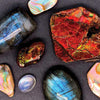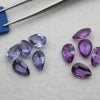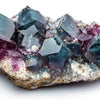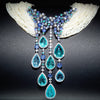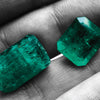Alexandrite: The Color-Changing Marvel of the Gem World
- by Greta Fontanella

“Emerald by day, ruby by night” — this poetic phrase captures the unique magic of alexandrite, one of the rarest and most fascinating gemstones in the world. With its dramatic color-change phenomenon, rich history, and scarcity, alexandrite is a true collector’s gem that bridges the worlds of science and mysticism.
Discovered in the 19th century and cherished ever since, alexandrite has become synonymous with rarity, transformation, and elegance.
A Gem of Changing Light
What sets alexandrite apart is its ability to shift color under different lighting. In daylight or fluorescent light, the stone appears green to bluish-green. Under incandescent light or candlelight, it transforms into red, purplish-red, or raspberry.
This color-change effect is due to a rare combination of chromium and the gem's crystal structure, which absorbs and reflects different wavelengths of light depending on the source.
The science of the shift:
-
Daylight contains more blue and green wavelengths → green hues dominate.
-
Incandescent light emits more red wavelengths → red hues take over.
This optical marvel is known as metamerism, and only a handful of gemstones in the world display it as vividly as alexandrite.

Origins and Historical Significance
Alexandrite was first discovered in the Ural Mountains of Russia in the early 1830s. Legend has it that it was named in honor of the Russian Tsar Alexander II, as it was found on his coming-of-age day.
In Imperial Russia, alexandrite quickly became a national gemstone — its green and red colors echoing the colors of the old Russian military uniform. It symbolized luck, power, and rebirth and was considered a stone of prestige and nobility.
Other major sources:
-
Sri Lanka – larger crystals but generally lighter color and less dramatic change
-
Brazil – high-quality deposits discovered in the 1980s, with intense color shifts
-
Tanzania – newer deposits with vibrant, often purplish tones
-
India and Madagascar – additional commercial sources with variable quality
True Russian alexandrites are extremely rare today and command premium prices.
How Rare Is Alexandrite?
Extremely. Alexandrite is rarer than almost any other mainstream gemstone, including rubies, sapphires, and even emeralds. This is due to the precise geological conditions required to form it:
-
The presence of beryllium, which is rare in itself
-
Alongside chromium, which rarely coexists with beryllium
-
In a low-iron, high-pressure metamorphic environment
This geological “perfect storm” is why fine alexandrites over 1 carat are incredibly scarce — especially those with strong color change and minimal inclusions.
Quality Factors: What to Look For
When evaluating alexandrite, gemologists consider four major qualities:
-
Color Change
-
The most desirable stones shift from vivid bluish-green to intense purplish-red
-
A dramatic and complete color change (ideally 100%) increases value
-
-
Clarity
-
Most alexandrites have some inclusions
-
Eye-clean stones are rare and command high premiums
-
-
Cut
-
Precision cutting is essential to showcase the color change
-
Ovals, cushions, and rounds are most common
-
-
Carat Weight
-
Fine stones over 1 carat are rare
-
Prices per carat increase exponentially with size and quality
-
Note: Natural alexandrite is very different from synthetic alexandrite, which is commonly used in lower-priced jewelry. Always request a gemological certificate when purchasing high-value stones.
Treatments and Lab Testing
Most natural alexandrites are not treated, which adds to their appeal among collectors. However, due to their value and rarity, lab-created versions are widespread.
To confirm authenticity:
-
Use certified gem labs (GIA, AGL, IGI, GRS)
-
Check for spectral analysis that confirms chromium content and color-change performance
-
Verify origin, especially if Russian
Synthetic alexandrite can look convincing but is typically produced using the Czochralski or flux-melt methods and may contain telltale growth lines or different inclusions.
Value and Pricing
Alexandrite is one of the most expensive gemstones per carat when it meets all premium criteria. Prices can be astounding — particularly for:
-
Stones with strong color change
-
Eye-clean clarity
-
Over 1 carat in size
-
Russian origin
Price ranges (as of 2025):
-
0.5–1.0 ct fine quality: $5,000–$20,000 per carat
-
1.0–2.0 ct exceptional stones: $25,000–$50,000+ per carat
-
Russian origin, antique, or auction pieces: $75,000+ per carat
Alexandrite in Jewelry
Due to its rarity, alexandrite is most often seen in:
-
Custom-designed rings
-
Vintage and estate jewelry
-
Birthstone pieces for June (shared with pearl and moonstone)
-
Collectible one-of-a-kind designs
Jewelry Tips:
-
Pair with white diamonds to emphasize both color phases
-
Use white gold or platinum for a modern, cool-tone look
-
Bezel settings or protective prongs are ideal due to its 7.5–8.5 Mohs hardness
Alexandrite is durable enough for rings and daily wear but should still be treated with care — avoid extreme heat, sudden temperature changes, and harsh cleaners.
Symbolism, Lore, and Metaphysical Meaning
Alexandrite has always carried an air of mystery, transformation, and duality. In crystal healing and metaphysical circles, it is associated with:
-
Balance between heart and mind
-
Change, adaptability, and spiritual growth
-
Intuition and inner wisdom
Because of its dramatic color change, alexandrite is often seen as a stone of contradiction and harmony, symbolizing the coexistence of opposites.
Summary
| Feature | Description |
|---|---|
| Mineral Type | Chrysoberyl |
| Color Change | Green in daylight → Red in incandescent light |
| Hardness | 8.5 (Mohs) |
| Key Sources | Russia, Brazil, Sri Lanka, Tanzania |
| Coloring Agent | Chromium |
| Treatments | Rarely treated; synthetics common |
| Use | High-end jewelry, birthstone for June, collectible pieces |
| Price per Carat | Up to $50,000+ depending on origin and quality |
- Posted in:
- alexandrite
- alexandrite engagement ring
- chrysoberyl
- collector gemstones
- color change gemstone
- dual-color gem
- emerald by day ruby by night
- fine jewelry stones
- gemstone investment
- June birthstone
- natural alexandrite vs synthetic
- rare gems
- Russian alexandrite

